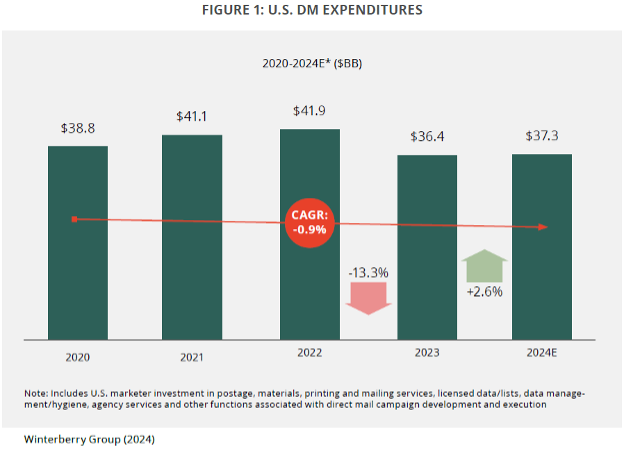

By: Chet Dalzell, Digital Advertising Alliance
A new white paper recently released by Winterberry Group shows that U.S. brands will grow their spending on direct mail advertising by an estimated 2.6 percent in 2024, reaching $37.3 billion – reversing last year’s (2023) double-digit percentage spending decline.
Amid this comeback, eight in ten U.S. brands say they plan to grow their direct mail investment in 2025, based on Winterberry’s survey of U.S. media decision makers.
Postage Drives Value-Based Use of Medium, Rather Than Volume
While postage costs now account for roughly half the cost of a direct mail ad, brands are shifting from volume-based use of the medium to more strategic, value-based use – driven by significant data-driven technology innovations and deeper orchestration of direct mail efforts with other marketing channels, according to the report titled “Delivering Performance 2024: Direct, Digital and the Dynamics Shaping the Future of Omnichannel Marketing.”
“While it’s true that postage rate increases have had a clear impact on direct mail activity, volume trends tell only a small part of the story of how brands are investing in this pioneering data-driven media channel,” said Jonathan Margulies, managing partner, Winterberry Group, and lead author of the report. “Brands have increasingly been working to deploy direct mail in concert with their omnichannel marketing programs – not just in digital media, but also in offline media and CTV [connected television]. The ‘mail moment’ is being driven today by a number of these marketing investments, among other marketplace drivers.”

Marketplace Drivers – Among Them Addressability Challenges in Digital Media, Better Data Quality
According to Margulies, the key drivers behind the reinvigoration of direct mail spending include:
- Growing investment in marketing spend overall (supported by macroeconomic growth)
- Growing cost and challenges in addressability of competitive digital media, as cookie deprecation and privacy regulation diminish the efficiency of search, social and programmatic display advertising (which are often seen as competitive performance-oriented channels); and
- Improved data quality and accessibility linking postal addresses with commercially available personal and household digital identifiers – enabling “trigger-driven” direct mail programs.
“While silos among media channels are diminishing, there remains for many marketers an ‘attribution gap’ when direct mail is deployed in the media mix,” Margulies said, noting that brands will continue to invest in the analytics necessary to close this gap. “In addition, while machine learning and AI [artificial intelligence] may have long-term disruptive potential, most of today’s most significant gains are being generated through innovative tactics that have been in the works for some time – leveraging techniques such as retargeting based on digital media, third-party marketing tech integration, direct mail triggers and QR codes.”

How Brands Can Optimize Their Use of the Medium
The report also provides a recommended course of action for brands to optimize their direct mail investment, he said, focusing on the medium as a performance vehicle, cross-channel measure-and-test discipline, data-driven technology investment – and the introduction of generative AI and machine learning into the strategy, creative and measurement processes. “There is no on/off switch for integrating marketing silos – it’s an evolution,” Margulies said.
Winterberry Group’s report is based on primary survey and interview research of more than 200 U.S. brand, agency and other marketing executives who deploy direct mail advertising within their media mix, conducted during the summer and fall of 2024. A full copy of the study may be downloaded here.
The December 2024 study has been made possible through the support of the U.S. Postal Service (as presenting sponsor), Canon and RRD (premier sponsors) and Alliant, Modern Postcard, Moore, Who’s Mailing What! and Wilen Group (founding sponsors).
Register for our 2025 Annual Outlook Luncheon with Winterberry Group
Winterberry Group will be back with Marketing Club of New York on Thursday, January 23, 2025 – to present its “Annual Outlook” for data, advertising and marketing across all media channels, among them direct mail, at a club luncheon event at Arno in New York’s Fashion District. The event is sponsored by Alliant. Registration is open through early January 23.
Related Posts
MCNY Kicks Off 2025: ‘Annual Outlook’ for U.S. Ad, Marketing and Data Spend to Grow 6.1 Percent – with Digital, CTV Acceleration; Decline in Linear TV, Print
Winterberry Group Senior Managing Partner Bruce Biegel MCNY KICKS OFF 2025: ‘ANNUAL OUTLOOK’ FOR U.S.…
Report: Direct Mail Advertising Makes a 2024 Comeback Amid Higher Postage | Brands Emphasize Omnichannel Integration
By: Chet Dalzell, Digital Advertising Alliance A new white paper recently released by Winterberry Group…
MCNY Announces 40th Annual Silver Apple Honorees: 11 Marketing Leaders
Special awards for advocacy, innovation and ‘Green Apple’ for a rising star among them The…
The One Global Advertising Competition that MCNY ‘Endorses’ — Get Involved with the 2024 International ECHO Awards
By: Chet Dalzell What truly makes great advertising? This week, every year, the world’s advertising…







